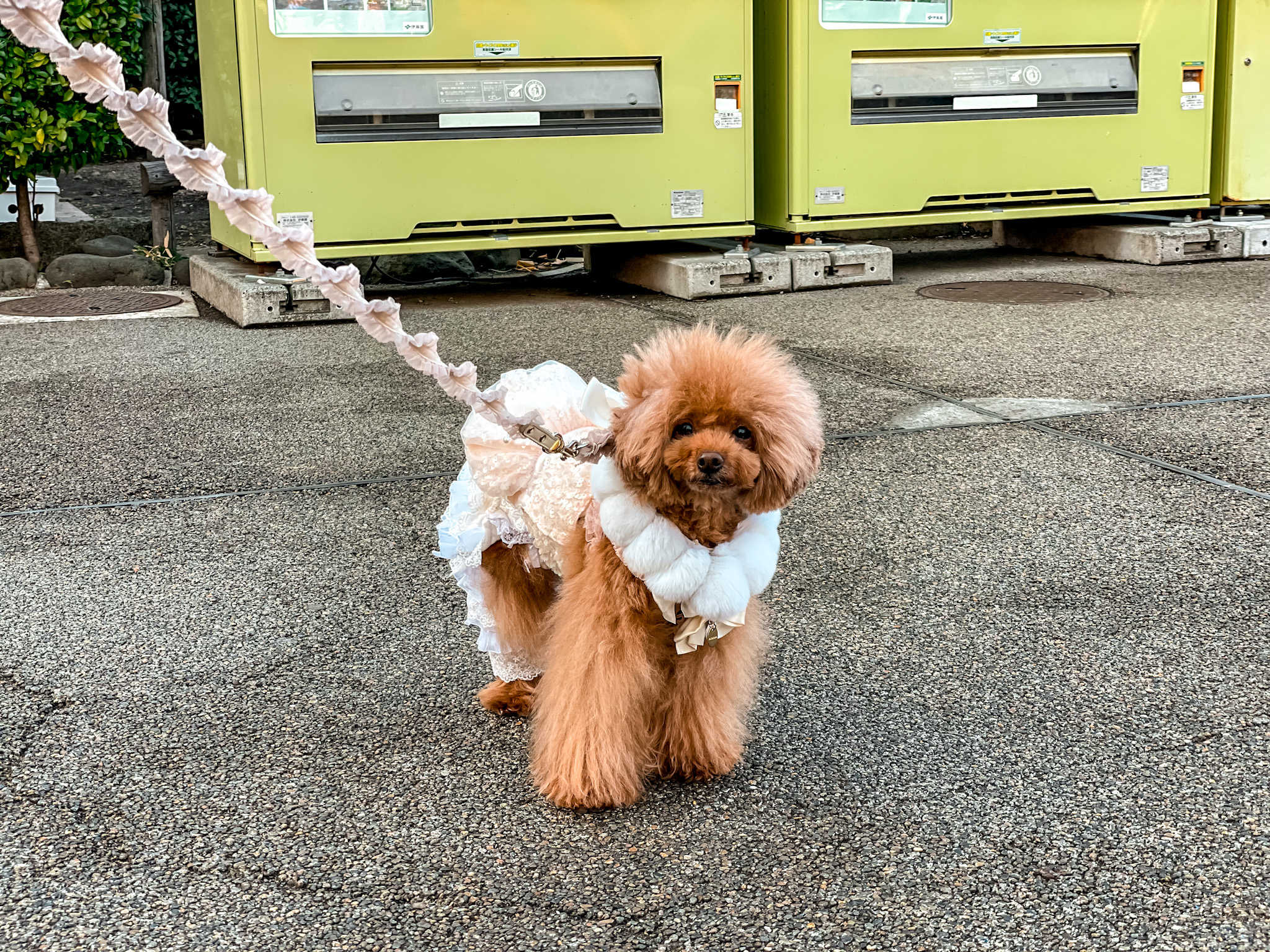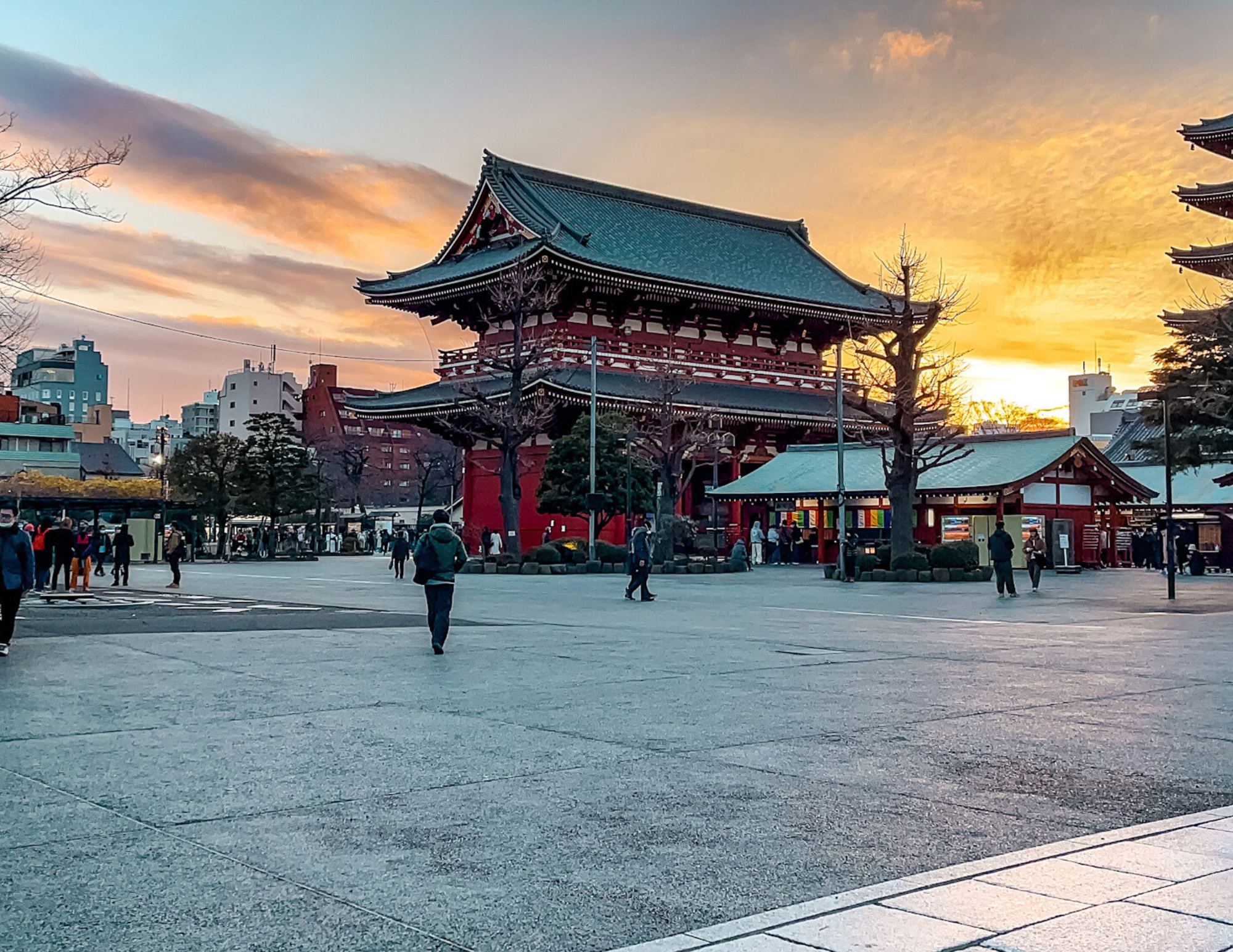The first thing that hit me wandering around Asakusa? How spotless Tokyo is. Leaves being swept off the sidewalks, not a gum wrapper in sight, and somehow… not that many trash cans either, so you just carry your bits until you find a bin. It works, and the streets sparkle. I hopped off at Asakusa with zero agenda, just a beautiful December day, solo because the boys stayed in, and followed the crowd toward Sensō-ji. Red lanterns, wooden gates, incense on the breeze… it’s the Tokyo picture in your head, but real.
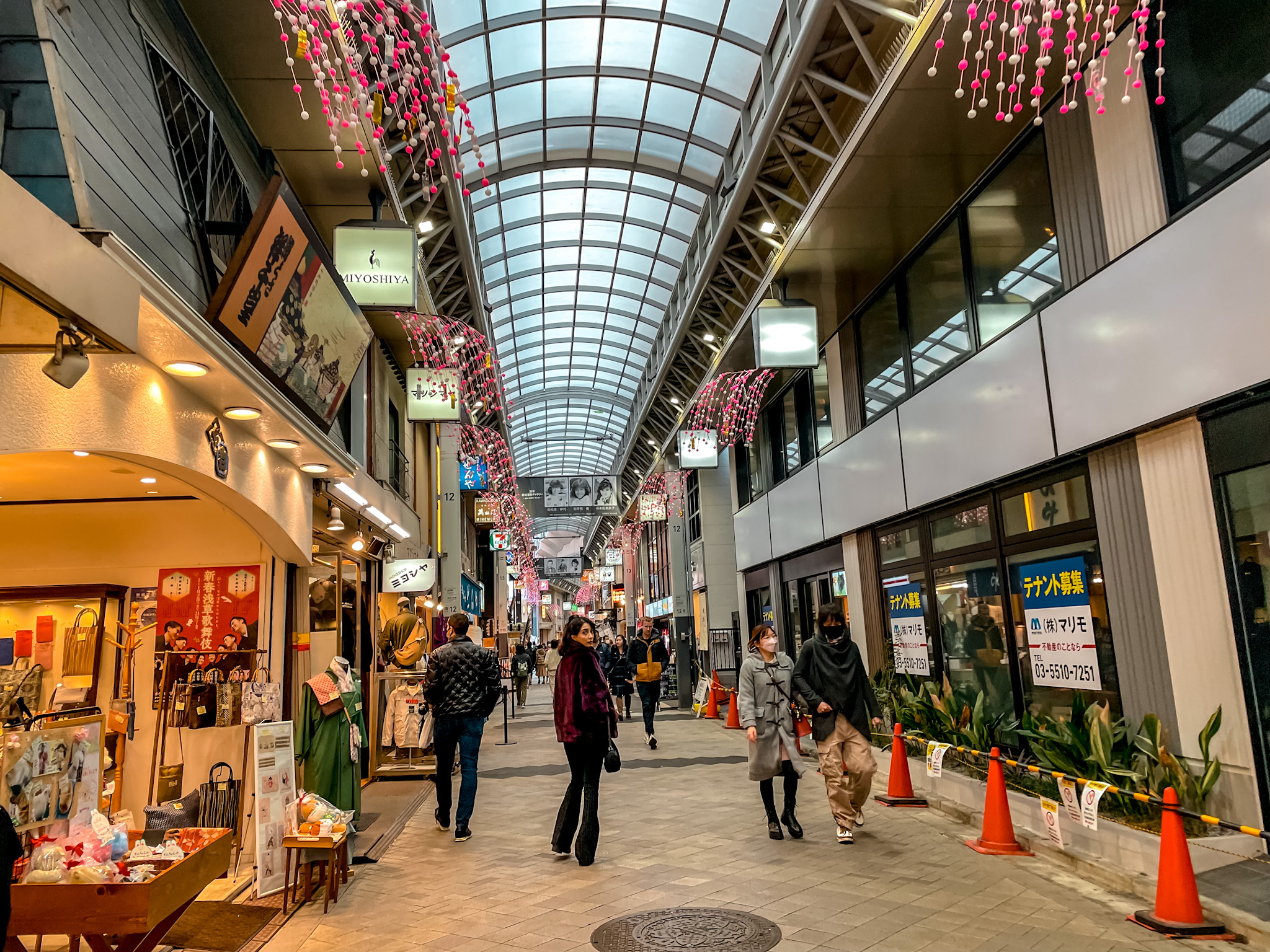
I slipped through Kaminarimon and strolled Nakamise-dōri, the old shopping street lined with snack stands and souvenir shops, before the path opened to Hōzōmon, a five-story pagoda, and the main hall. Sensō-ji is Tokyo’s oldest temple (founded in the 7th century) and still one of its most visited…lively, photogenic, and a little bit magical even when it’s packed. Grounds are open day and night, but the main hall keeps hours (early morning to late afternoon). If you’ve got time, the East Garden side paths are quieter, and the smoke of the incense burner feels like a reset button.
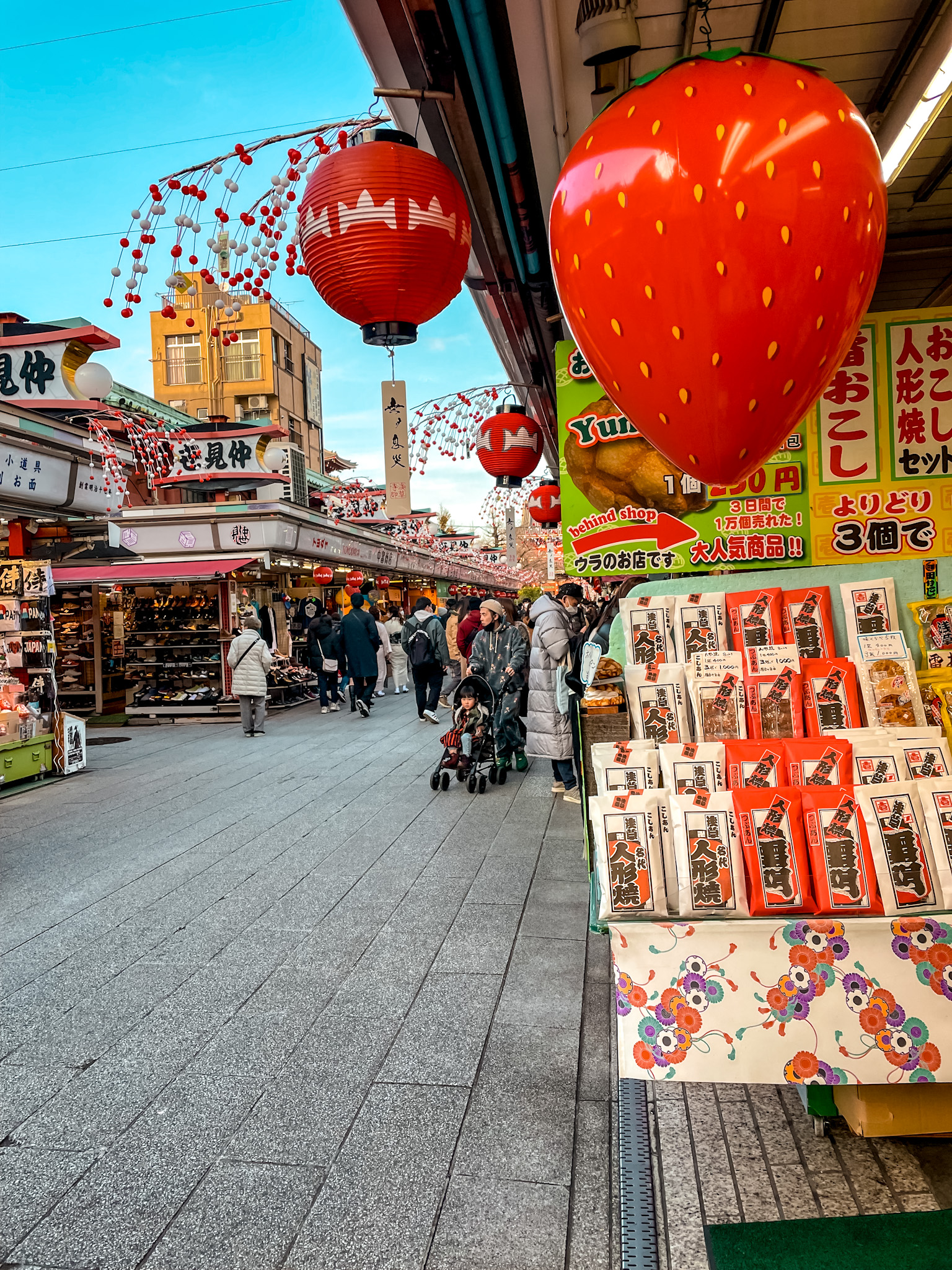
I took my time. Peeked at omikuji fortunes, people-watched, and then went hunting for the two sweets I’d been eyeing forever: taiyaki and tanghulu. Taiyaki is that cute fish-shaped cake. Crisp outside, soft inside and traditionally filled with sweet red bean paste. I hesitated (beans in dessert, my Jamaican brain said “rice and peas!”), but listen… 10/10, would demolish again. Tanghulu is a Chinese treat that’s blown up across Asia and Tokyo lately: strawberries on a skewer, dipped in hot sugar so the shell shatters and the fruit inside is juicy and cold. It’s sweet-sweet, but fun, and very “I’m-in-Asakusa” energy.
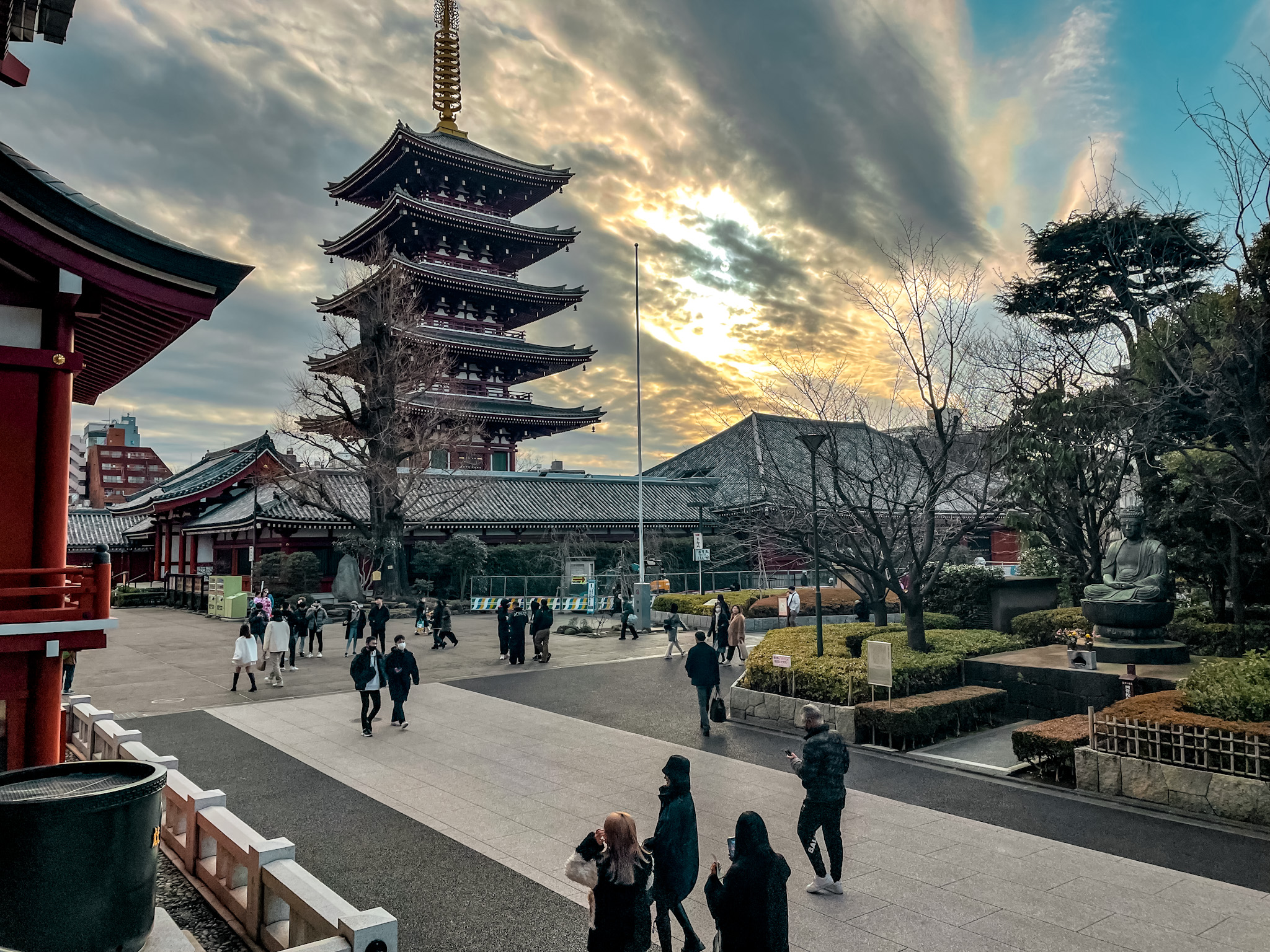
What & where (so you don’t miss the good stuff)
Sensō-ji, the heart of Asakusa
Start at Kaminarimon (Thunder Gate), walk Nakamise for snacks and souvenirs, pass Hōzōmon, and step into the Main Hall. Sensō-ji dates to 645 and honors Kannon; it sees tens of millions of visitors annually, but it still manages moments of calm, especially early morning or later in the evening when the lanterns glow. Temple grounds 24/7; main hall typically 6:00–17:00 (6:30–17:00 Oct–Mar). Dress casually modest and move with the flow.
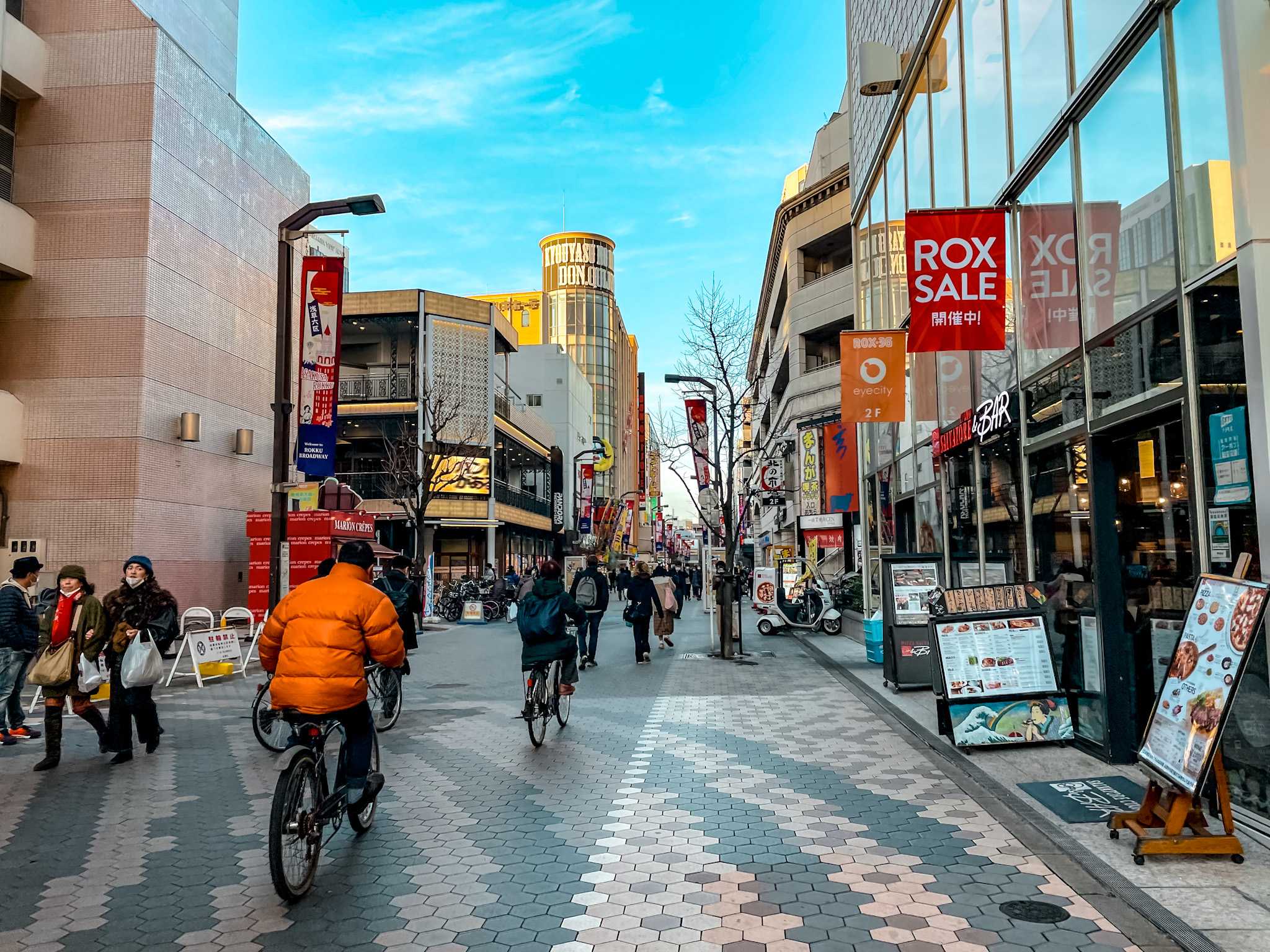
Nakamise Shopping Street (snacks & souvenirs)
Nakamise is the approach street, about 250 meters long, with traditional sweets, senbei crackers, fans, and trinkets. Most shops run roughly 9:00–19:00 (varies by storefront), so if you want it quiet-quiet, go early; if you want it buzzy, come late morning. Try something warm and fresh…taiyaki, ningyō-yaki, anything that smells like butter.
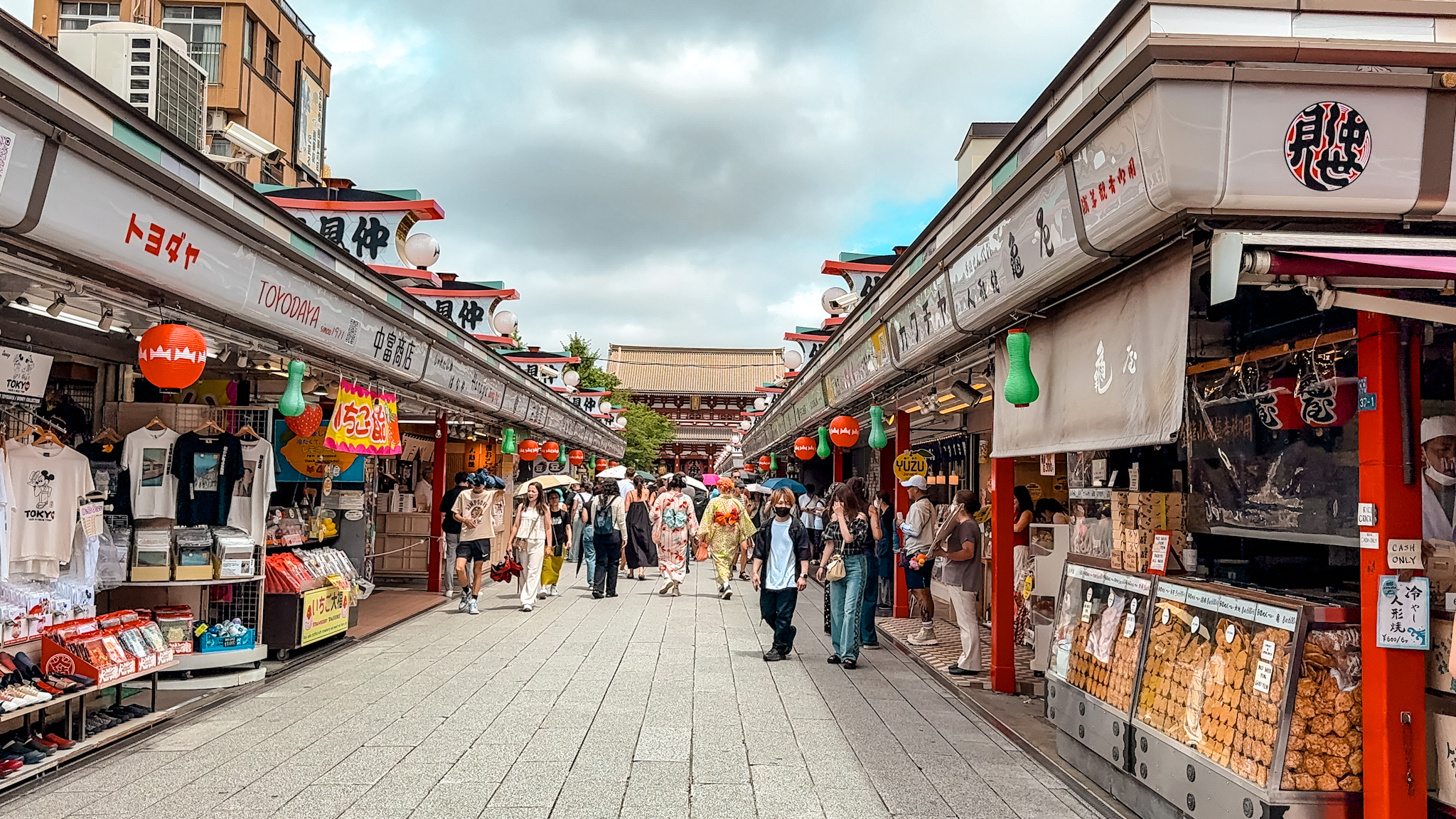
Free viewpoint: Asakusa Culture & Tourist Information Center
Across from Kaminarimon is a handsome wooden building by Kengo Kuma with a free rooftop terrace (elevator up!) for head-on views down Nakamise toward the temple. Open daily 9:00–20:00; terrace typically until 22:00; café 10:00–20:00. It’s my go-to for bearings, photos, and a bathroom stop.
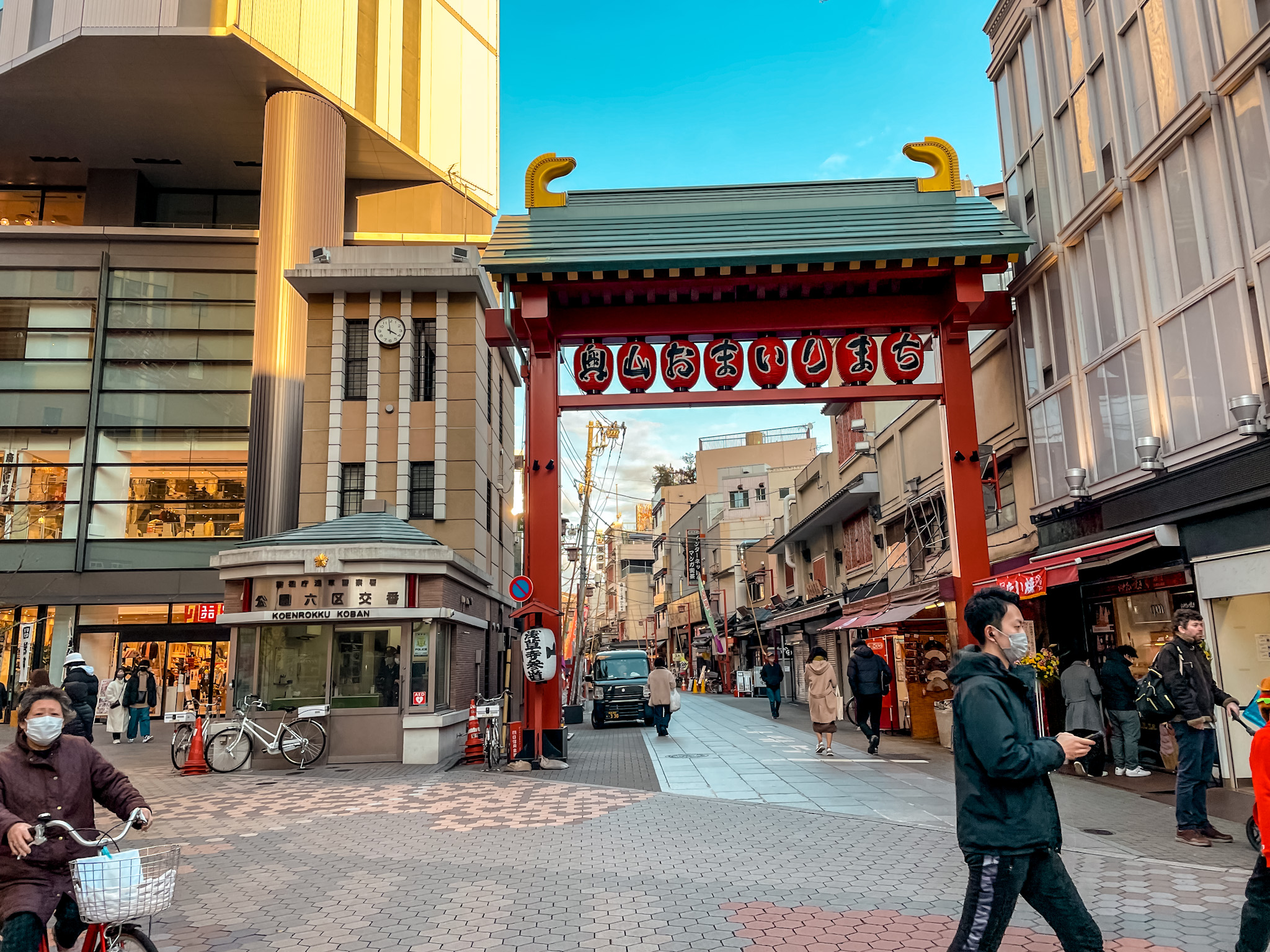
Hanayashiki Amusement Park (retro fun five minutes away)
Duck behind the temple and you’ll stumble into Hanayashiki, Japan’s oldest amusement park (Edo-period origins!). It’s tiny, a bit chaotic, and charming, perfect if you’re with kids or just want a nostalgic ride on the rooftop “Roller Coaster.” Check the daily hours before you wander over.
Sumida Park & summer fireworks
For a river breeze, walk to Sumida Park; in late July, the Sumidagawa Fireworks light up the sky (and half of Tokyo shows up, arrive early if you’re going). On regular nights it’s just a pretty riverside stroll with Skytree peeking over the roofs.
Eat this (and why it’s worth it)
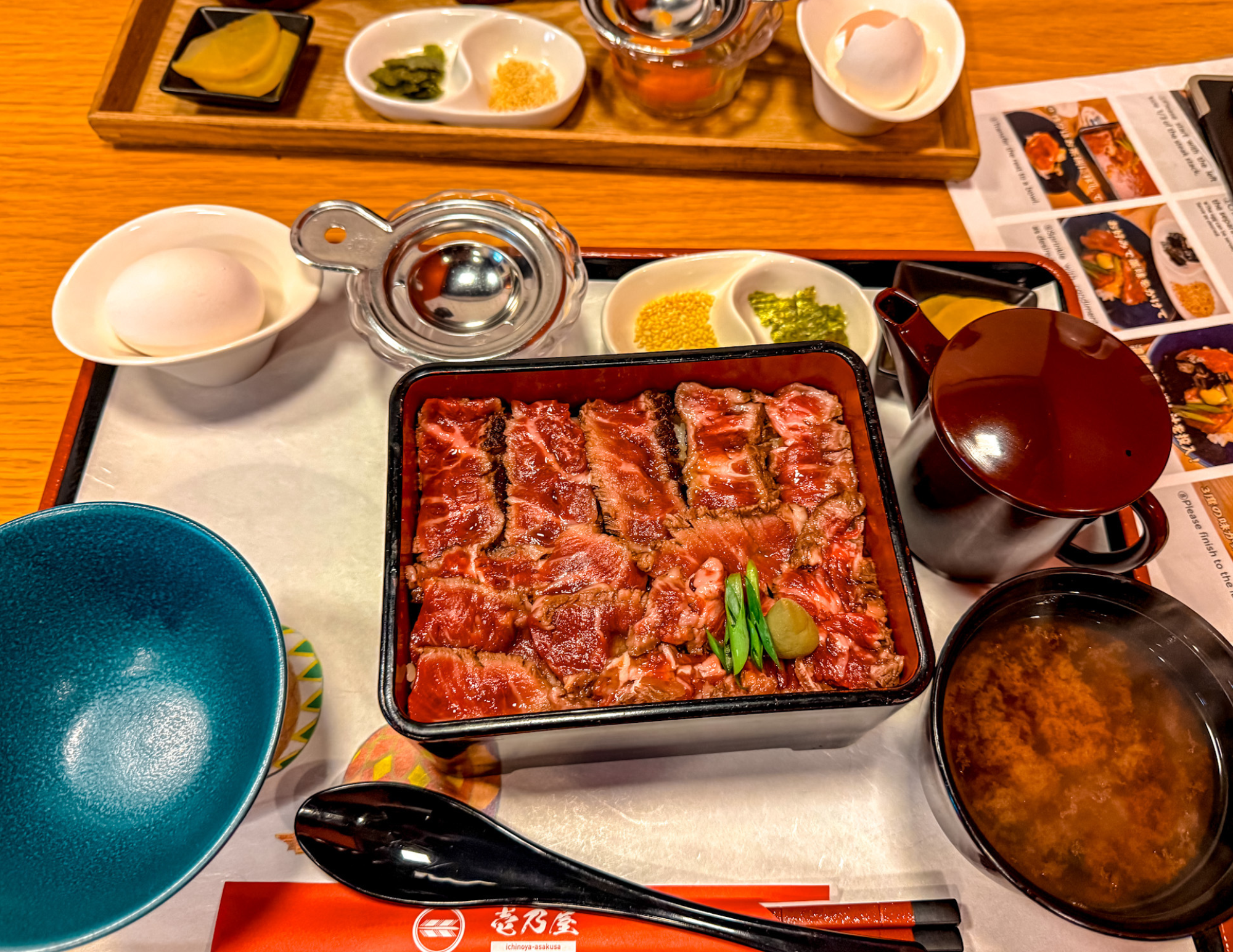
Kuroge Wagyu Ichinoya Asakusa - rare wagyu steak bowl served “three ways” (steps from Sensō-ji)
This is the wagyu bowl spot everyone whispers about in Asakusa, and yes, it lives up to the hype. The signature is a rare steak donburi built from carefully selected kuroge wagyu (plus domestic Japanese beef cuts). You eat it hitsumabushi-style in three stages: first bites as-is to taste the meat; then mix in the egg yolk for silky richness; finally pour the light broth/dashi over the last third for an ochazuke finish. Bowls come with condiments, pickles, and miso—simple, focused, unforgettable. Go a little early or late afternoon to dodge the peak line; they often close when sold out.
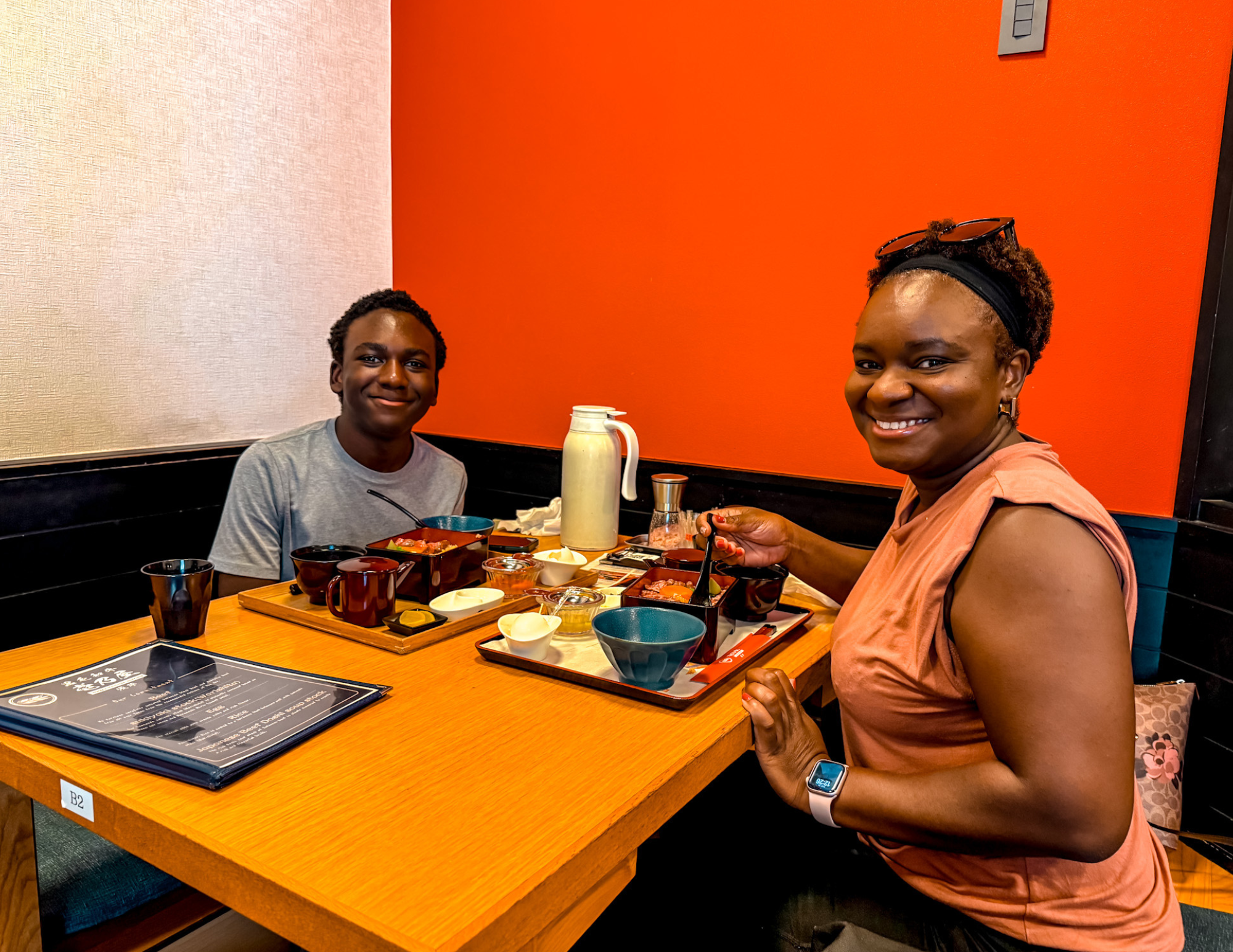
What to order: the Premium Rare Steak Box (brisket) or the Melting Tenderloin Steak Box; you can upsize meat 1.5× for a splurgey portion.
Typical prices: Premium box about ¥3,300; Tenderloin box about ¥5,500 (rice upsize +¥100; extra meat +¥1,100 to +¥2,200). Expect a lighter option around the low-¥2,000s on some sets.
Hours & lines: Usually late morning → mid-afternoon (e.g., 11:00–17:00 at the Osakaya-bldg location, 10:30–16:00 at the Denbōin shop). They may sell out early—aim for opening or ~3pm. No reservations for the steak-bowl shops.
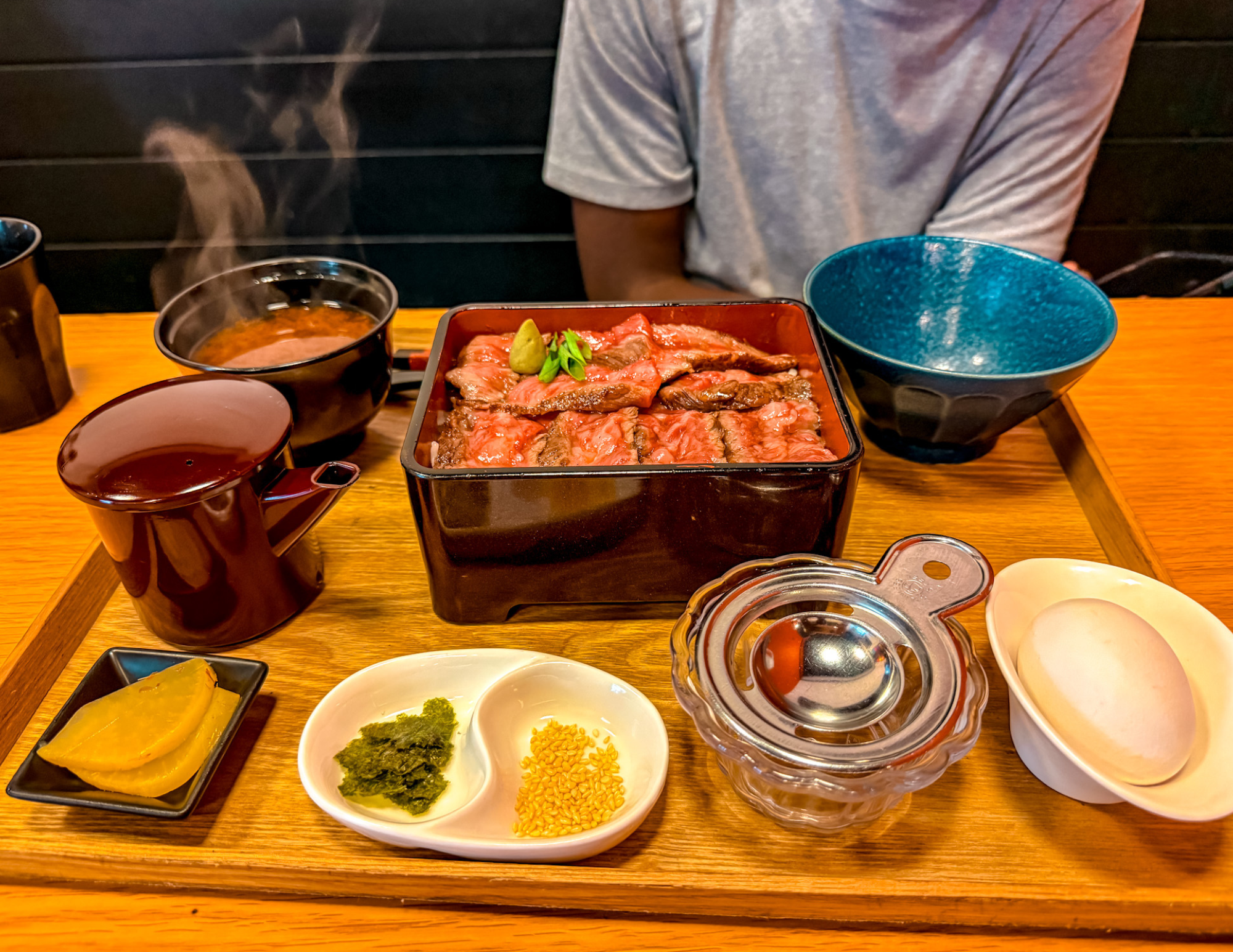
Where it is: Osakaya Building 1F, 1-34-6 Asakusa, Taitō (about a 5–7-minute walk from Asakusa Station on the Ginza/Asakusa lines). There’s also a Denbōin-dōri location nearby.
Pro tip (don’t mix up): “Wagyu Sukiyaki Ichinoya Asakusa” is a separate sister restaurant with bookable sukiyaki courses (Yonezawa beef, different experience). Great too, but not the quick steak-bowl shop above.
Want more? read the full blog post here
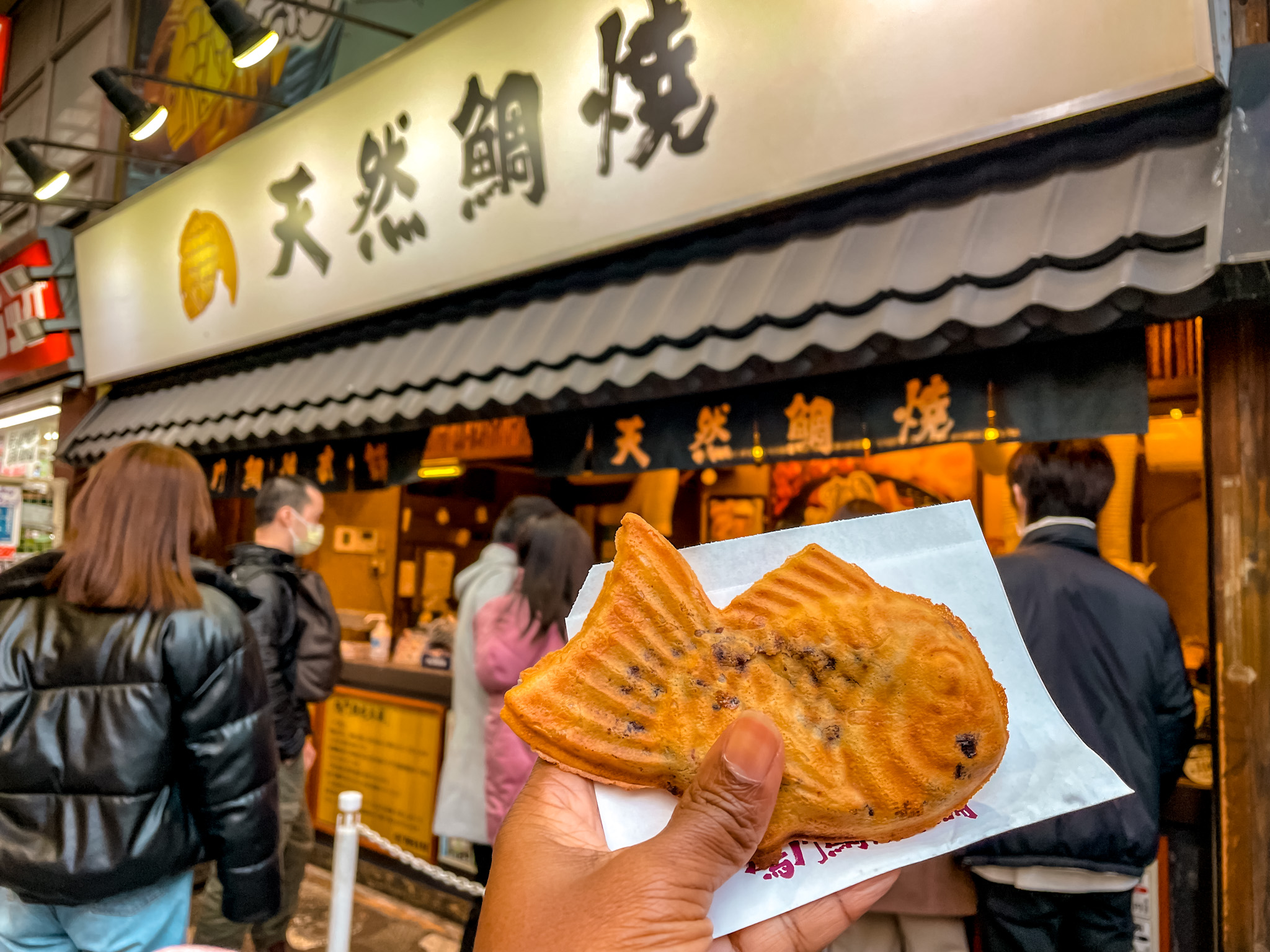
Taiyaki - fish-shaped, griddled, traditionally filled with anko (sweet red bean); now you’ll also see custard, chocolate, sweet potato, even soft-serve variations. It’s festival-famous for a reason: warm, crisp, perfect in your hand.
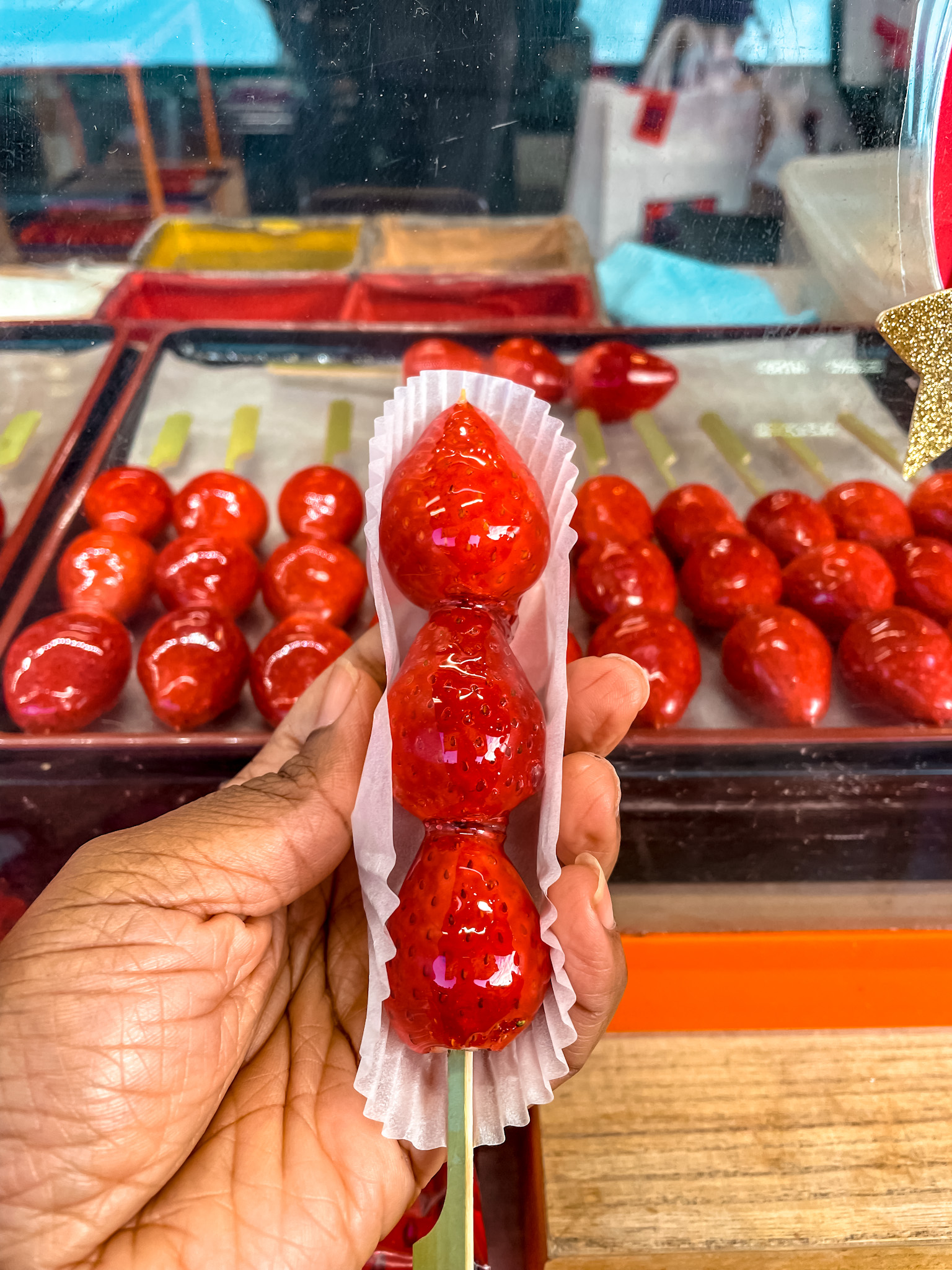
Tanghulu - candied fruit on a stick (strawberries and grapes are common). It’s a Chinese classic that’s gone super-viral in Japan and beyond; you’ll spot queues near Sensō-ji on busy days. Crunchy shell, juicy center, pure sugar rush.
PS: Strawberries in Japan really are next-level… and the price tags know it. Treat yourself to one skewer and thank me later.
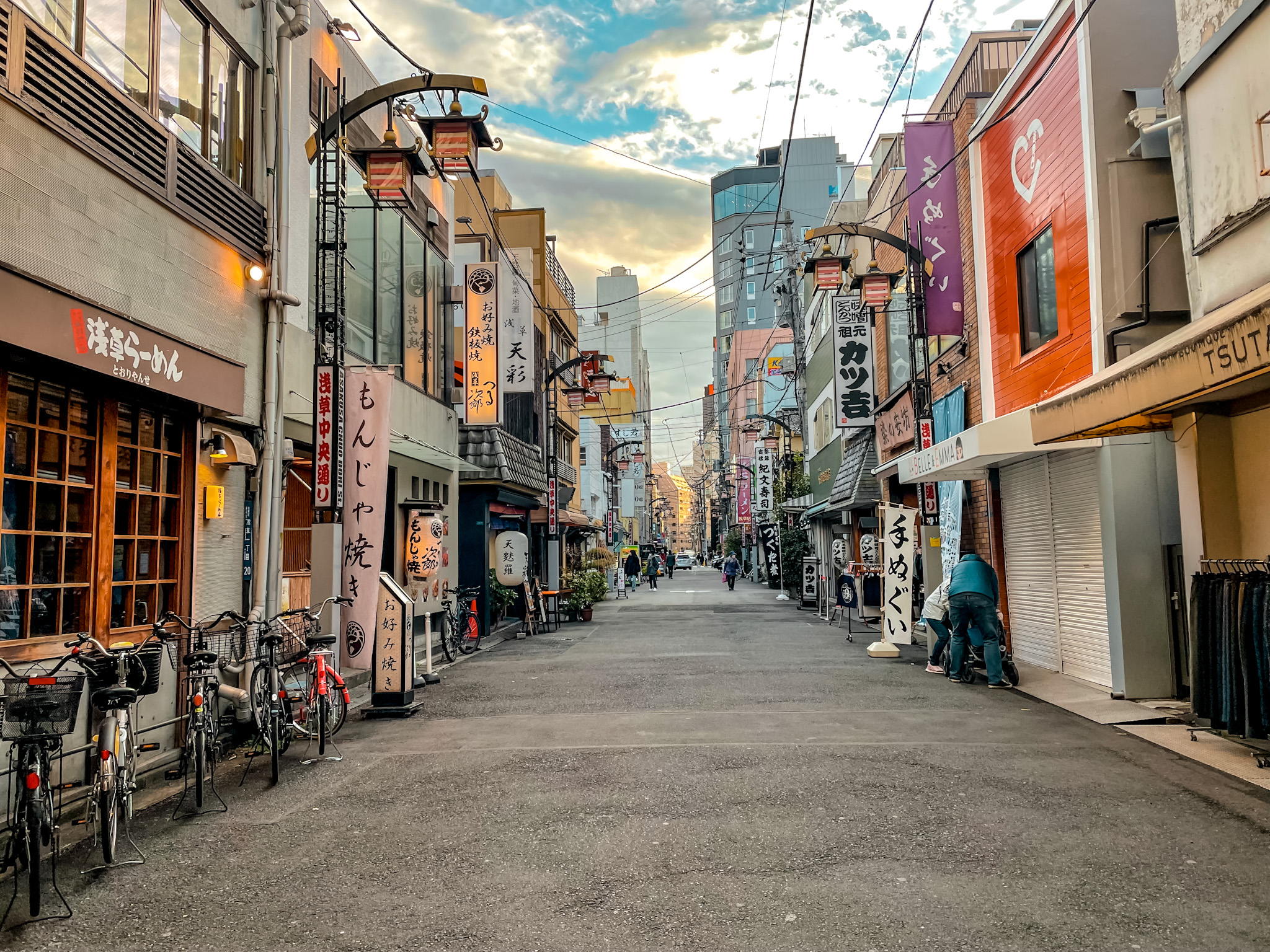
Getting there (and around) like a pro
Asakusa isn’t on JR; instead use Tokyo Metro Ginza Line, Toei Asakusa Line, Tobu Skytree Line, or Tsukuba Express (different station a few blocks away). Ginza Line Exit 1 or Toei A4/A5 pop you out close to Kaminarimon. From Haneda, most Keikyu/Asakusa Line trains run direct to Asakusa (no transfer). From Asakusa it’s one stop on Tobu or a 15-minute walk to Tokyo Skytree.
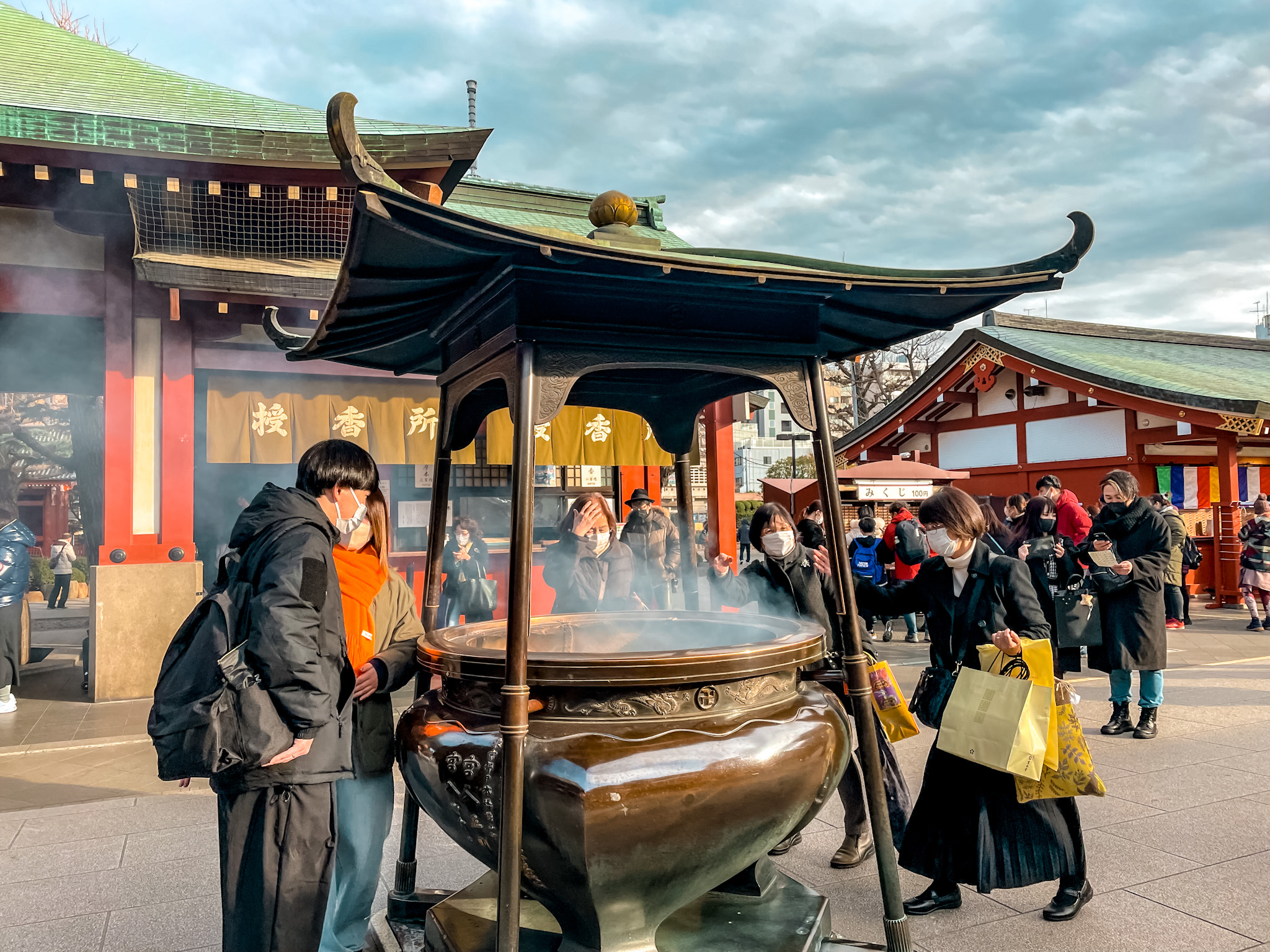
My tiny timeline (what a chill visit looks like)
I came solo (the boys were in hibernation mode), wandered Nakamise with a snack in hand, lingered at the incense burner, and looped back to the tourist center rooftop for that classic view down to the gate. I took a quick peek at Hanayashiki, grabbed taiyaki while it was still chimney-hot, and committed to tanghulu for science. Crowd-wise, it was humming, tourism is fully back, so I saved the quiet photos for the evening glow on my way out.
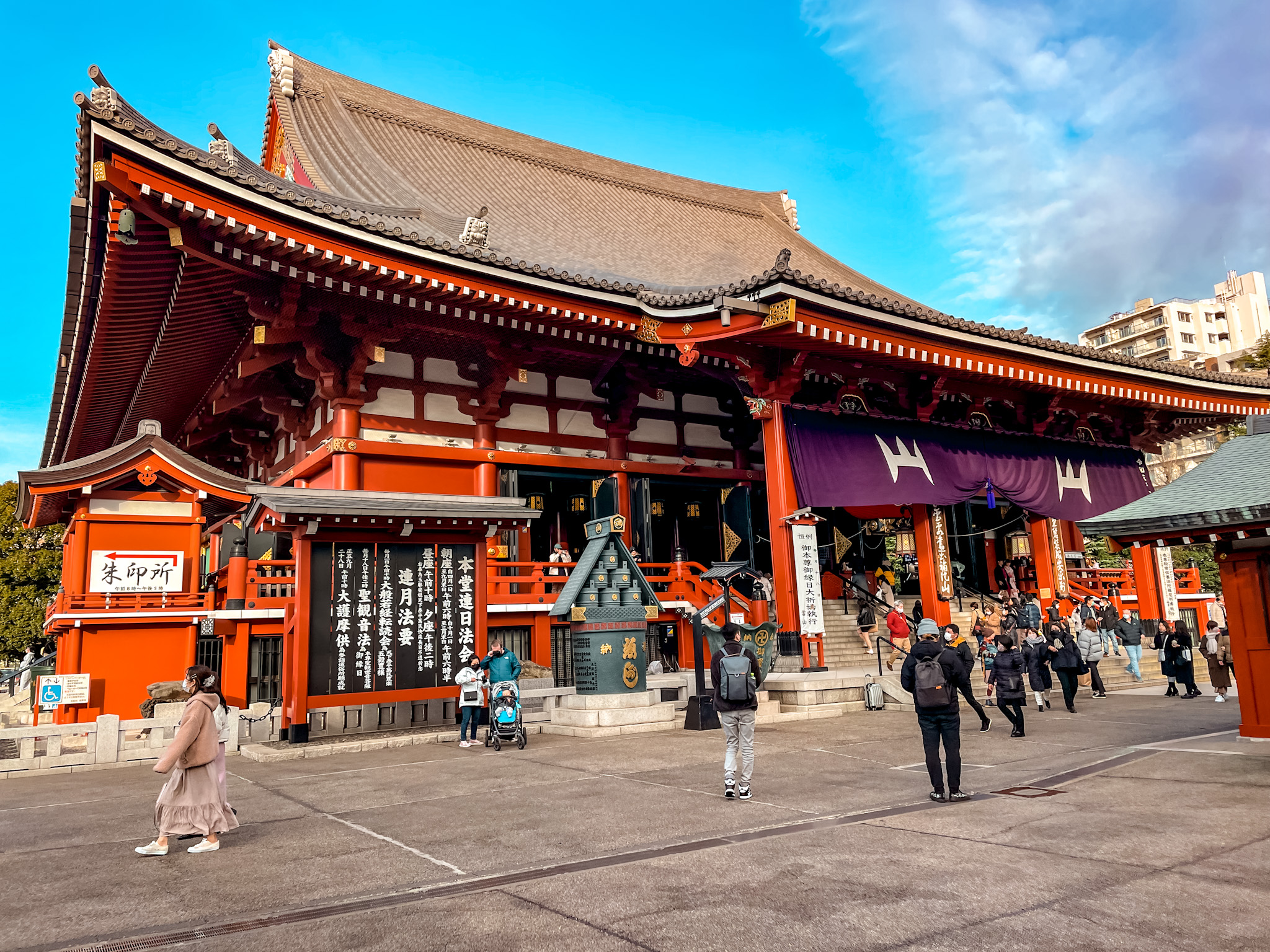
If you have half a day (do this)
Start early: photos at Kaminarimon before the tour groups, main hall when it opens, omikuji for fun, Nakamise snacks, up to the free rooftop for a look back, then stroll Sumida Park or pop into Hanayashiki if you’ve got kids in tow. Come back after dark if you can, the lanterns make the temple look brand new.
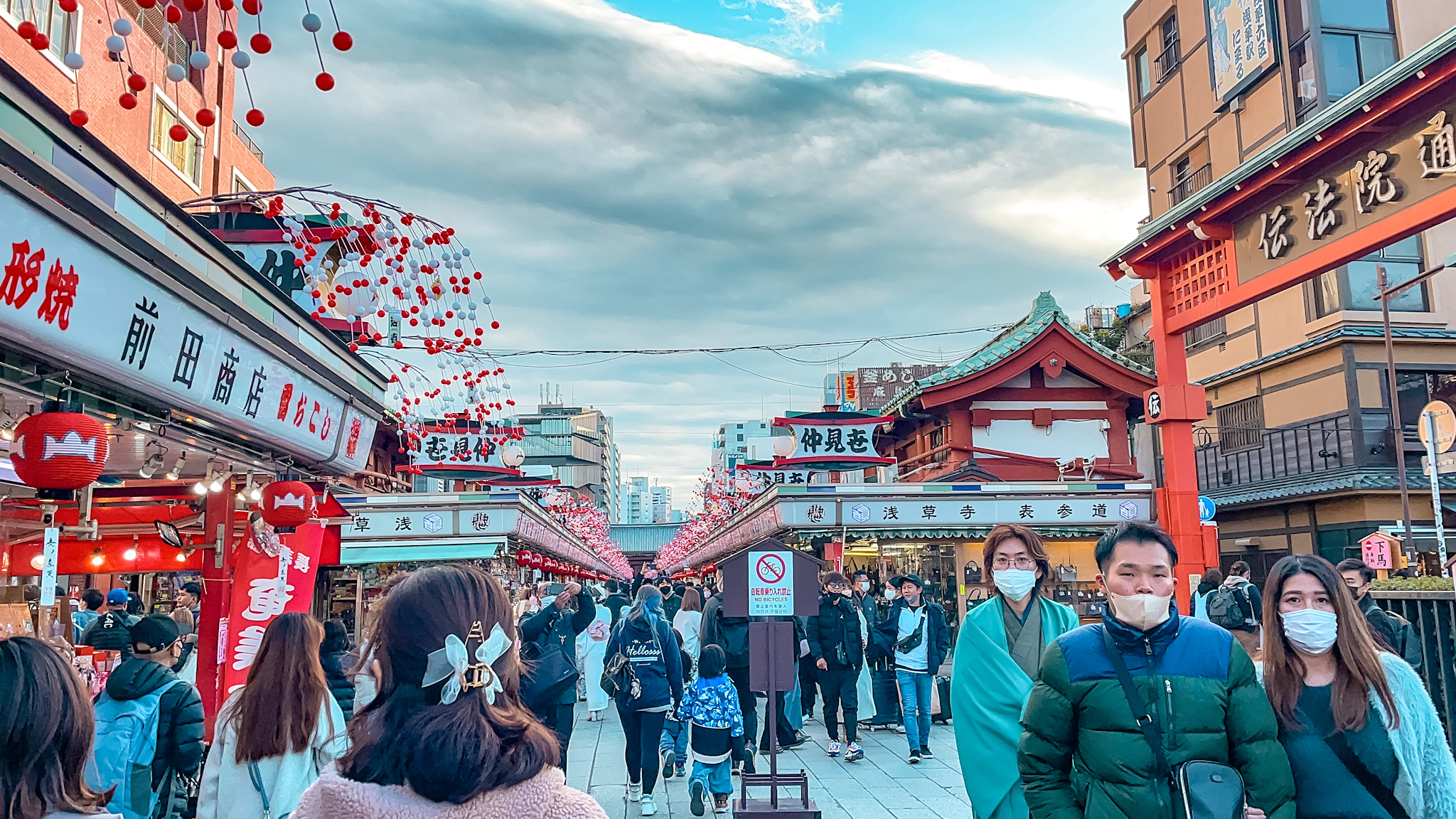
Good-to-know tips
Hours: Sensō-ji grounds are open all the time; main hall is typically 6:00–17:00 (from 6:30 Oct–Mar). Shops on Nakamise vary but roughly 9:00–19:00. Mondays/Fridays can affect some facilities, always peek at signage.
Etiquette: At the main hall, you can wash hands at the temizuya, fan a little smoke on yourself from the incense burner, and bow lightly before moving on.
Cash & bins: Many small stands are cash-leaning (though more take IC cards now). Trash cans are scarce, carry a tiny bag and drop at convenience stores or inside stations.
With kids: Hanayashiki is right there; the park’s retro rides are quick wins. Rooftop terrace at the tourist center is stroller-friendly (elevator access).
Festival note: Late July = Sumidagawa Fireworks. Crowds are intense; arrive hours early or book a riverside spot/boat if you hate jostling.
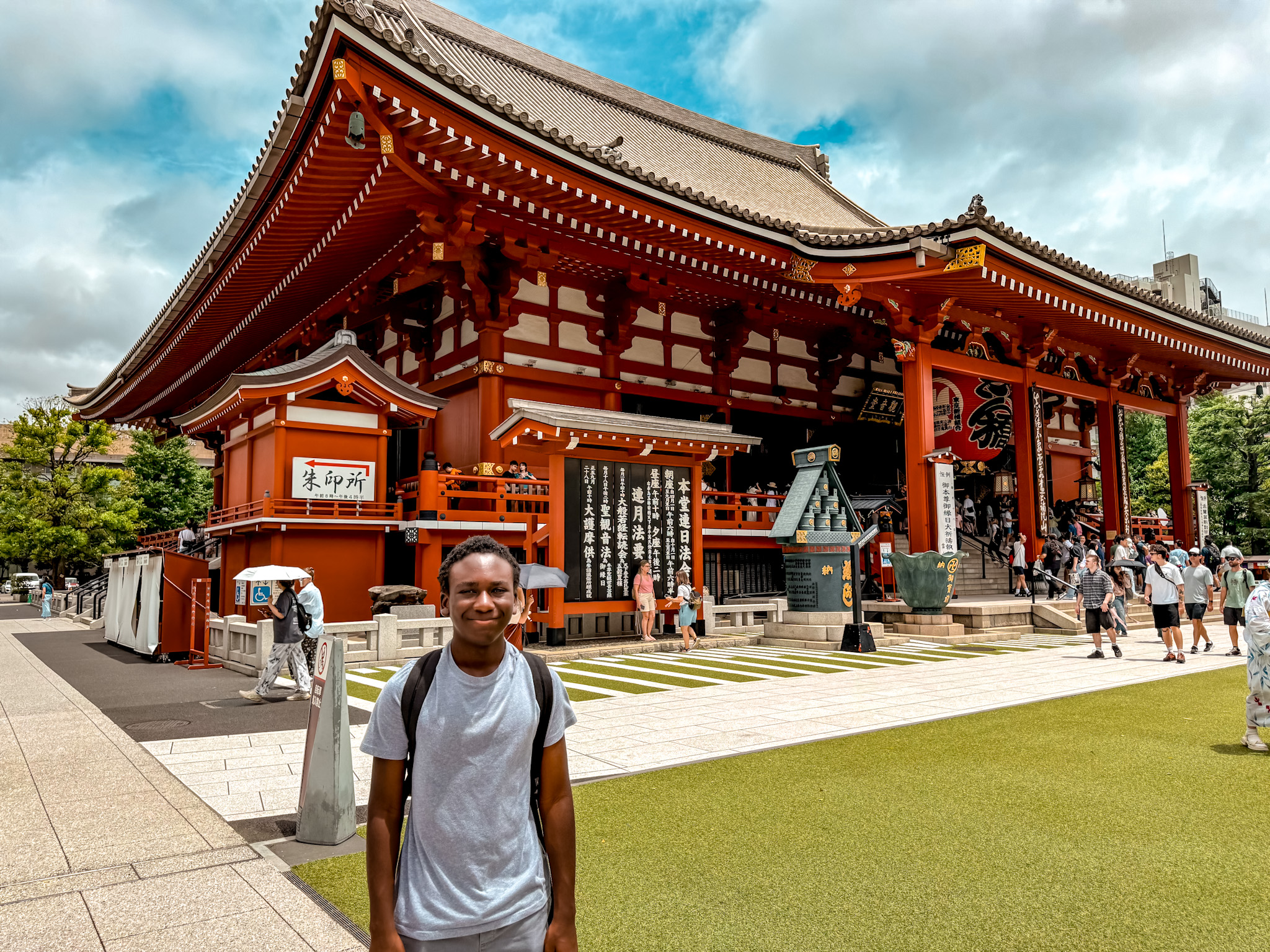
I revisited in 2025
Coming back a couple years later, Asakusa felt the same, just busier. The observation deck remained my sanity move (views without the squeeze), Hanayashiki had refreshed some offerings, and tanghulu had gone full trend with lines near the temple on weekends. Summer nights on the Sumida were shoulder-to-shoulder again for fireworks. Plan your timing and you’ll love it even with the crowds.
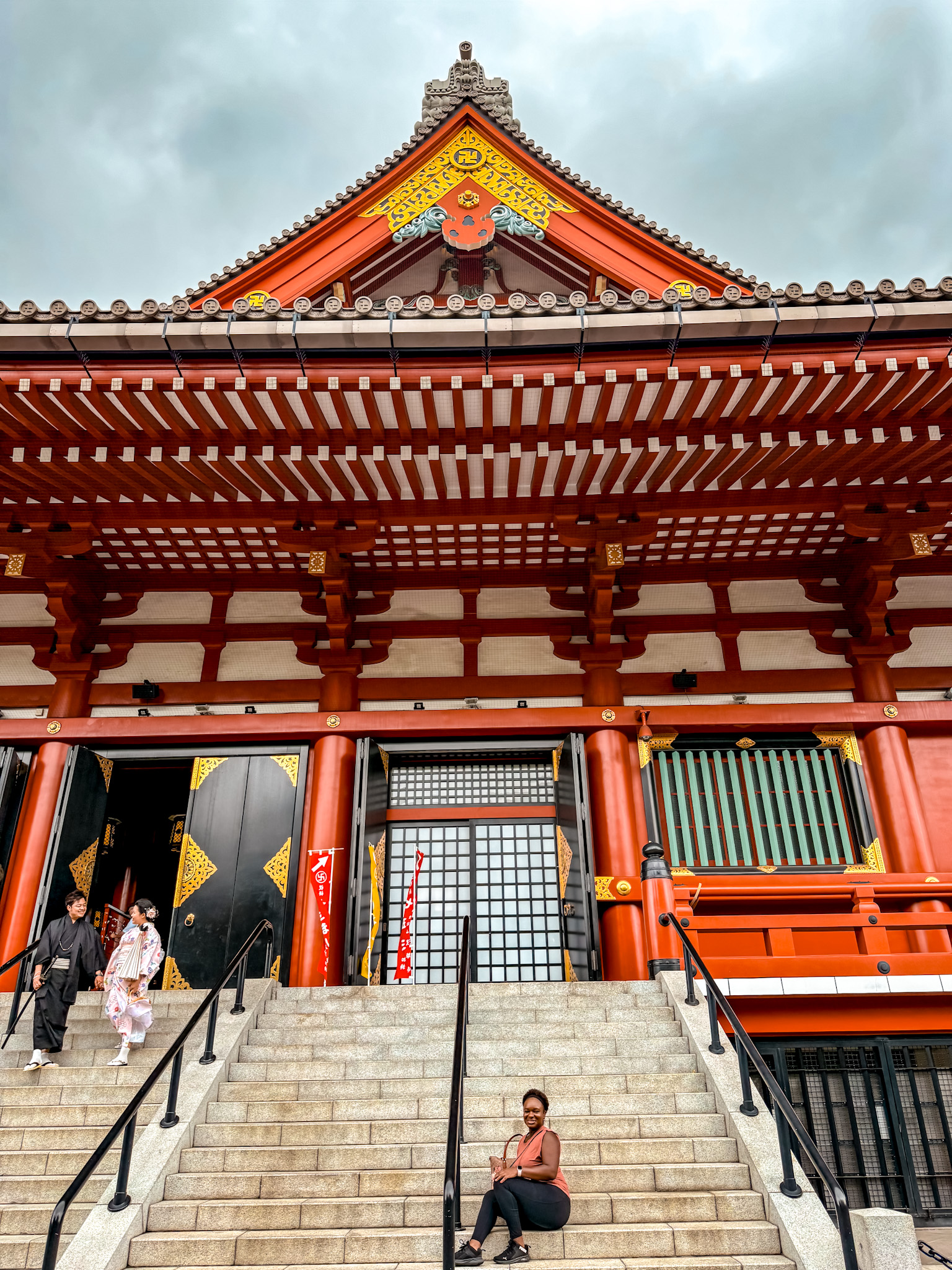
FAQ
Is Sensō-ji free?
Yes. The grounds are free; the main hall is free during opening hours.
When is the best time to visit?
Early morning or after sunset for fewer people and beautiful light; weekends and holidays are the busiest.
Where’s the best free view?
Asakusa Culture & Tourist Information Center rooftop across from Kaminarimon.
How do I get to Asakusa from Haneda?
Take Keikyu from Haneda; it through-runs onto the Toei Asakusa Line, many trains go direct to Asakusa. About 40 minutes depending on service.
Can I reach Skytree from Asakusa?
Yes. 1 stop on the Tobu Skytree Line or a 15-minute walk across the river.
